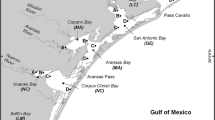Abstract
High and often variable salinity is an obvious feature of salt lakes. Correspondingly, salinity is usually assumed to be an important ecological determinant in such lakes. An investigation of the macroinvertebrate fauna of 79 lakes (salinities from 0.3 to 343 g 1−1) in the Western District of Victoria, Australia, examined this assumption. Over the total range of salinity, species richness and composition are highly correlated with salinity. However, these relationships become nonsignificant over intermediate ranges of salinity. Furthermore, many taxa have very broad tolerances to salinity at these intermediate ranges, implying that factors other than salinity may determine their distribution. An appreciation of scale (that is, the range of salinity over which observations are considered) resolves the paradox that, despite these broad tolerances by most taxa, species richness and composition strongly reflect salinity over the entire salinity range.
Similar content being viewed by others
References
Austin, M. P., 1985. Continuum concept, ordination methods, and niche theory. Annu. Rev. Ecol. Syst. 16: 39–61.
Beadle, L. C., 1959. Osmotic and ionic regulation in relation to the classification of brackish and inland saline waters. Arch. Oceanogr. Limnol. (Suppl.): 143–151.
Chessman, B. C. & W. D. Williams, 1974. The distribution of fish in inland saline waters in Victoria, Australia. Aust. J. mar. Freshwat. Res. 25: 167–172.
Colburn, E. A., 1988. Factors influencing species diversity in saline waters of Death Valley, USA. Hydrobiologia 158: 215–226.
De Deckker, P. & M. C. Geddes, 1980. Seasonal fauna of ephemeral saline lakes near the Coorong Lagoon, South Australia. Aust. J. mar. Freshwat. Res. 31: 677–699.
De Deckker, P. & W. D. Williams, 1988. Physico- chemical limnology of eleven, mostly saline permanent lakes in western Victoria, Australia. Hydrobiologia 162: 275–286.
Faith, D. P., P. R. Minchin & L. Belbin,1987. Compositional dissimilarity as a robust measure of ecological distance. Vegetatio 69: 57–68.
Galat, D. L., M. Coleman & R. Robinson, 1988. Experimental effects of elevated salinity on three benthic invertebrates in Pyramid Lake, Nevada. Hydrobiologia 158: 133–144.
Gauch, H. G., 1982. Multivariate Analysis in Community Ecology. Cambridge University Press, Cambridge.
Gauch, H. G. & R. H. Whittaker, 1981. Hierarchical classification of community data. J. Ecol. 69: 135–152.
Geddes, M. C., 1975. Studies on an Australian brine shrimp Parartemia zietziana Sayce (Crustacea: Anostraca). 1. Salinity tolerance. Comp. Biochem. Physiol. 51A: 553–560.
Geddes, M. C., 1976. Seasonal fauna of some ephemeral saline waters in western Victoria with particular reference to Parartemia zietziana Sayce (Crustacea: Anostraca). Aust. J. mar. Freshwat. Res. 27: 1–22.
Hammer, U. T., 1986. Saline Lake Ecosystems of the World. Junk, Dordrecht.
Hammer, U. T. & J. M. Heseltine, 1988. Aquatic macrophytes in saline lakes of the Canadian prairies. Hydrobiologia 158: 101–116.
Herbst, D. B., 1988. Comparative population ecology of Ephydra hians Say (Diptera: Ephydridae) at Mono Lake (California) and Albert Lake (Oregon). Hydrobiologia 158: 145–166.
Hill, M. O., 1979. TWINSPAN-A FORTRAN program for arranging multivariate data in an ordered two-way table by classification of the individuals and attributes. Cornell University, Ithaca, New York.
Hill, M. O., R. G. H. Bunce & M. W. Shaw, 1975. Indicator species analysis, a divisive polythetic method of classification and its application to a survey of native pinewoods in Scotland. J. Ecol. 63: 597–613.
Kerfoot, W. C. & M. Lynch, 1987. Branchiopod communities: Associations with planktivorous fish in space and time. In: W. C. Kerfoot & A. Sih (Eds) Predation: Direct and Indirect Impacts on Aquatic Communities. University Press of New England, Hanover & London.
Kokkinn, M. J. & W. D. Williams, 1988. Adaptations to life in a hypersaline water-body: adaptations at the egg and early embryonic stage of Tanytarsus arbitarsis Freeman (Diptera: Chironomidae). Aquatic Insects 10(4): 205–214.
Lancaster, J. & Scudder, G. G. E., 1987. Aquatic Coleoptera and Hemiptera in some Canadian saline lakes: patterns in community structure. Can. J. Zool. 65: 1383–1390.
Melack, J. M. (ed.), 1988a Saline lakes. Developments in Hydrobiology, 44. Dr. W. Junk Publishers, Dordrecht. 316 pp.
Melack, J. M., 1988b. Primary producer dynamics associated with evaporative concentration in a shallow, equatorial soda lake (Lake Elmenteita, Kenya). Hydrobiologia 158: 1–14.
Minchin, P. R., 1986. How to use ECOPAK: an ecological database system. Tech. Mem. 86/6. CSIRO, Australia.
Minchin, P. R.,1987. An evaluation of the relative robustness of techniques for ecological ordination. Vegetatio 69: 89–107.
Remane, A. & C. Schlieper, 1971. Biology of Brackish Water. Schweitzerbart'sche, Stuttgart.
Scudder, G. G. E., 1983. A review of factors governing the distribution of two closely related corixids in the saline lakes of British Columbia. Hydrobiologia 105: 143–145.
Timms, B. V., 1983. A study of benthic communities in some shallow saline lakes of western Victoria, Australia. Hydrobiologia 105: 165–177.
Vareschi, E., 1987. Saline lake ecosystems. In: E.-D. Schultze & H. Zwölfer (eds.). Potentials and Limitations of Ecosystem Analysis. Springer Verlag, Berlin.
Whittaker, D. M., 1940. The brine shrimp Artemia and its environment. Science Monthly 51: 192–193.
Williams, W. D., 1981. The limnology of saline lakes in western Victoria. Hydrobiologia 82: 233–259.
Williams, W. D., 1984. Chemical and biological features of salt lakes on the Eyre Peninsula, South Australia, and an explanation of regional differences in the fauna of Australian salt lakes. Verh. int. Ver. Limnol. 22: 1208–1215.
Williams, W. D., 1986. Conductivity and salinity of Australian salt lakes. Aust. J. mar. Freshwat. Res. 37: 117–182.
Williams, W. D. & R. T. Buckney, 1976. Stability of ionic proportions in five salt lakes in Victoria, Australia. Aust. J. mar. Freshwat. Res. 27: 367–377.
Williams, W. D. & M. J. Kokkinn, 1988. The biogeographical affinities of the fauna in episodically filled salt lakes: a study of Lake Eyre South, Australia. Hydrobiologia 158: 227–236.
Wood, R. B. & J. F. Talling, 1988. Chemical and algal relationships in a salinity series of Ethiopian inland waters. Hydrobiologia 158: 29–67.
Author information
Authors and Affiliations
Rights and permissions
About this article
Cite this article
Williams, W.D., Boulton, A.J. & Taaffe, R.G. Salinity as a determinant of salt lake fauna: a question of scale. Hydrobiologia 197, 257–266 (1990). https://doi.org/10.1007/BF00026955
Issue Date:
DOI: https://doi.org/10.1007/BF00026955




